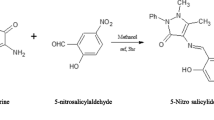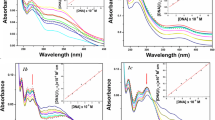Abstract
Mixed-ligand Cu(II), Co(II) complexes of formulae [Co(NSALT)(A.A)(H2O)](1), [Co(OHAPT)(A.A)H2O](2), and [Cu(ESALT)(ABPH)H2O] (3) were obtained by refluxing methanol solutions of copper, cobalt chlorides with the appropriate ligands. The complexes were characterized by the ESI-MASS, vibrational spectroscopy (Fourier transform-IR), 1H-NMR spectroscopy, UV–vis spectroscopy, TGA, ESR, SEM and powder XRD. The preliminary DNA-binding activity of the complexes was studied by recording electronic absorption spectra of the complexes in presence of CT-DNA. The binding constants of three complexes towards calf thymus DNA (CT-DNA) [1.2 × 104 M−1 for 1, 2.5 × 104 M−1 for 2, and 3.0 × 104 M−1 for 3] indicate strong interaction of 3. Changes in the fluorescence of ethidium bromide in the presence of DNA suggest intercalation into or electrostatic interactions with CT DNA. The quenching constants, KSV towards-DNA calculated through fluorescence spectra are 2.9 × 104 M−1for 1, 1.8 × 104 M−1 for 2, and 3.2 × 104 M−1 for 3. Docking studies on DNA complexes confirm the binding of 1 and 2 in the major groove of CT-DNA (CTP-1 Endonuclease). Moreover, the antibacterial effect of 1–3 against the five bacterial species was evaluated. The metal complexes have cleavage affinity towards PBR322 plasmid. Furthermore, the antioxidant activities of the complexes were determined by DPPH scavenging activity method.












Similar content being viewed by others
References
Guo Z, Sadler PJ (1999) Metals in medicine. Angew Chem Int Ed 38:1512–1531
Dyson P J, and Sava G (2006) Metal-based anti tumor drugs in the post genomic era. Dalton Trans 1929–1933. DOI: 10.1039/B601840H
Williams DR (1972) Metals, ligands, and cancer. Chem Rev 72:203–213
Romero-Canelón I, Sadler PJ (2013) Next-generation metal anticancer complexes: multitargeting via redox modulation. Inorg Chem 52:12276–12291
Bruijnincx PCA, Sadler PJ (2008) New trends for metal complexes with anticancer activity. Curr Opin Chem Biol 12:197–206
Campbell MJM (1975) Coord Chem Rev 15:279–312, 241–249
John RP, Sreekanth A, Kurup MRP, Usman A, Razak IA, Fun HK (2003) Spectral studies and structure of a 2-hydroxyacetophenone 3-hexamethyleneiminyl thiosemicarbazonate(−2) copper(II)complex containing 1,10- phenanthroline Spectrochem. Acta A 59:1349–1358
Liberta AB, West DX (1992) Antifungal and antitumor activity of heterocyclic thiosemicarbazones and their metal complexes: current status. BioMetals 5:121–126
Ali MA, Livingiston SE (1974) Coord Chem Rev 13:273
Yamada S (1999) Coord Chem Rev 192:537
Erkkila KE, Odom DT, Barton JK (1999) Chem Rev 99:2777
Armitage B (1998) Chem Rev 98:1171
Pogozelski WK, Tullius TD (1998) Chem Rev 98:1089
Mrksich M, Dervan PB (1993) Antiparallel side-by-side hetero dimer for sequence-specific recognition in the minor groove of DNA by a distamycin/1-methylimidazole-2-carboxamide-netropsin pair. J Am Chem Soc 115(7):2572–2576
Jiang GB, Xie YY, Lin GJ, Huang HL, Liang ZH, Liu YJ (2013) Synthesis, characterization, DNA interaction, antioxidant and anticancer activity studies of ruthenium(II) polypyridyl complexes. J Photochem Photobiol B 5(129):48–56
Marmur J (1961) A procedure for the isolation of deoxyribonucleic acid from micro-o rganisms. J Mol Biol 3:208–218
Saeed A, Al-Masoudi NA, Latif M (2013) Synthesis and antiviral activity of New substituted methyl [2-(arylmethylene-hydrazino)-4-oxo-thiazolidin-5-ylidene]acetates. Arch Pharm Chem Life Sci 346:618–625
Sukriye G, Ozdemir N, Bal-Demirci T, Ulkuseven B, Dincer M, Andac O (2010) Quantum-chemical, spectroscopic and X-ray diffraction studies on nickel complex of 2-hydroxyacetophenone thiosemicarbazone with triphenylphospine. Polyhedron 29:2393–2403
Xue L-W, Wang X, Zhao G-Q (2012) Synthesis, crystal structure, and atimicrobial activity of a novel trinuclear Cadmium(II) complex derived from 2-ethoxysalicylaldehydethiosemicarbazone synthesis and reactivity in inorganic. Metal-Org Nano-Metal Chem 42(9):1334–1338
Shobha Devi C, Anil Kumar D, Singh SS, Gabra N, Deepika N, Praveen Kumar Y, Satyanarayana S (2013) Synthesis, interaction with DNA, cytotoxicity, cell cycle arrest and apoptotic inducing properties of ruthenium(II) molecular “light switch” complexes. Eur J Med Chem 64(2013):410–421
Tan CP, Liu J, Chen LM, Shi S, Ji LN (2008) Synthesis, structural characteristics, DNA binding properties and cytotoxicity studies of a series of Ru(III) complexes. J Inorg Biochem 102(8):1644–1653
Cheung LM, Cheung PCK, OoiV EC (2003) Antioxidant activity and total phenolics of edible mushroom extracts. Food Chem 81:249–255
Anupama B, Sunita M, Shiva Leela D, Ushaiah B, Gyana Kumari C (2014) Synthesis, spectral characterization, DNA binding studies and antimicrobial activity of Co(II), Ni(II), Zn(II), Fe(III) and VO(IV) complexes with 4-aminoantipyrine schiff base of ortho-vanillin. J Fluoresc 24:1067–1076
Williams RS, Dodson GE, Limbo O, Yamada Y, Williams JS, Guenther G, Classen S, Glover JN, Iwasaki H, Russell P, Tainer JA (2009) Nbs1 flexibly tethers Ctp1 and Mre11-Rad50 to coordinate DNA double-strand break processing and repair. Cell 139(1):87–99. doi:10.1016/j.cell.2009.07.033
Morris GM, Huey R, Lindstrom W, Sanner MF, Belew RK, Goodsell DS, Olson AJ (2009) AutoDock4 and AutoDockTools4: automated docking with selective receptor flexibility. J Comput Chem 30:2785–2791
Morris GM, Goodsell DS, Halliday RS, Huey R, Hart WE, Belew RK, Olson AJ (1998) Automateddocking using a Lamarckian genetic algorithm and an empirical binding free energy function. J Comput Chem 19:1639–1662
Perugu S, Jalli H, Bhanoori M (2013) SSViewer: sequence structure viewer. Int J Innov Technol Exploring Eng (IJITEE) 3(4):2278–3075
Kavitha P, Saritha M, Laxma Reddy K (2013) Synthesis, structural characterization, fluorescence, antimicrobial, antioxidant and DNA cleavage studies of Cu(II) complexes of formyl chromone Schiff bases. Spectrochim Acta A Mol Biomol Spectrosc 102:159–168
Acknowledgments
We thank to University grants commission (UGC, NEW Delhi, India) for financial support in the form of junior research fellow to me. We thank to HCU for extending the ESR facility and Department of Bio chemistry (Osmania university, Hyderabad) for microbial activity.
Author information
Authors and Affiliations
Corresponding author
Electronic supplementary material
Below is the link to the electronic supplementary material.
ESM 1
(DOCX 1451 kb)
Rights and permissions
About this article
Cite this article
Ushaiah, B., leela, D.S., Ravi, M. et al. Synthesis, Characterization, Antibacterial, DNA Binding and Cleavage Studies of Mixed Ligand Cu(II), Co(II) Complexes. J Fluoresc 24, 1687–1699 (2014). https://doi.org/10.1007/s10895-014-1456-2
Received:
Accepted:
Published:
Issue Date:
DOI: https://doi.org/10.1007/s10895-014-1456-2




